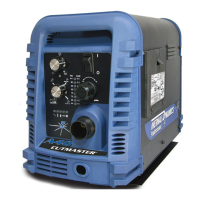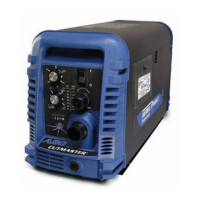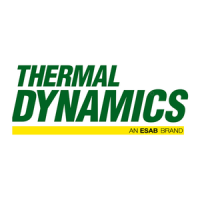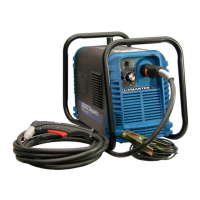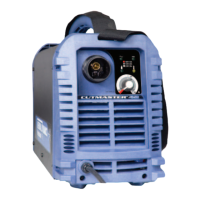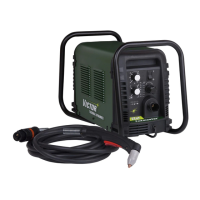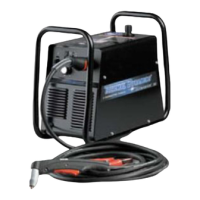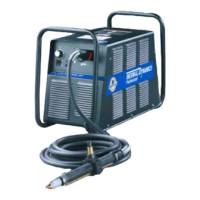CUTMASTER A120
Manual 0-4989 4T-3 OPERATION
Change the torch parts for a different operation as
follows:
WARNING
Disconnect primary power at the source before
assembling or disassembling torch parts, or
torch and leads assemblies.
NOTE
The shield cup holds the tip and starter car-
tridge in place. Position the torch with the
shield cup facing upward to keep these parts
from falling out when the cup is removed.
1. Unscrew and remove the shield cup assem-
bly from the torch head.
2. Remove the Electrode by pulling it straight
out of the Torch Head.
A-03510_AB
Electrode
Start Cartridge
Tip
Shield Cup
Torch Head
Torch Parts (Drag Shield Cap & Shield Cup
Body Shown)
3. Install the replacement Electrode by push-
ing it straight into the torch head until it
clicks.
4. Install the starter cartridge and desired tip
for the operation into the torch head.
5. Hand tighten the shield cup assembly until
it is seated on the torch head. If resistance
is felt when installing the cup, check the
threads before proceeding.
4T.04 Cut Quality
NOTE
Cut quality depends heavily on setup and
parameters such as torch standoff, align-
ment with the workpiece, cutting speed, gas
pressures, and operator ability.
Cut quality requirements differ depending on
application. For instance, nitride build - up and
bevel angle may be major factors when the sur-
face will be welded after cutting. Dross - free cut-
ting is important when nish cut quality is desired
to avoid a secondary cleaning operation. The
following cut quality characteristics are illustrated
in the following gure:
Cut Surface
Bevel Angle
Top Edge
Rounding
Cut Surface
Drag Lines
Dross
Build-Up
Top
Spatter
A-00007
Cut Quality Characteristics
Cut Surface
The desired or specified condition (smooth or
rough) of the face of the cut.
Nitride Build - Up
Nitride deposits can be left on the surface of the
cut when nitrogen is present in the plasma gas
stream. These buildups may create difficulties
if the material is to be welded after the cutting
process.
Bevel Angle
The angle between the surface of the cut edge
and a plane perpendicular to the surface of
the plate. A perfectly perpendicular cut would
result in a 0° bevel angle.
Top - Edge Rounding
Rounding on the top edge of a cut due to wear-
ing from the initial contact of the plasma arc on
the workpiece.
